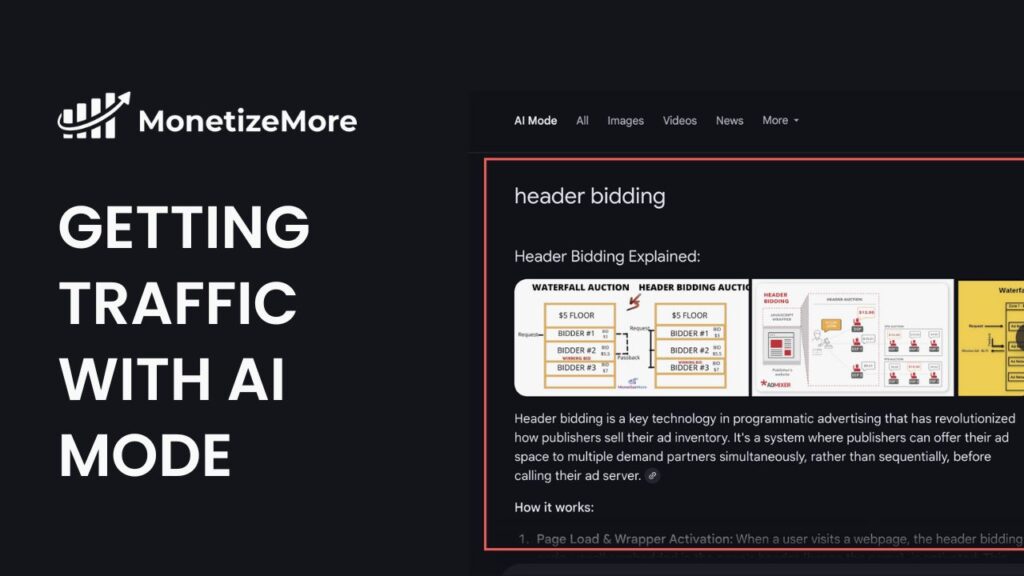This post was most recently updated on June 4th, 2025
Your Google traffic evaporated overnight. You followed the rules. You published great content. You built links. You optimized.
Now? Crickets.
AI Mode doesn’t “rank” pages; it synthesizes answers from passages across 50+ sources. Your beautifully crafted 3,000-word guide? Reduced to a 12-word soundbite and or ignored altogether.
Getting quoted by Gemini means NOTHING if users don’t click, remember you, or buy.
→ Your new KPI: Brand recall, conversions, and direct traffic. Stop chasing vanity.
The Party’s Over for Click-Throughs
Remember when driving traffic to your site was the ultimate goal? Those days might be numbered. AI-powered search is flipping the script; instead of sending users to your content, it’s shoving snips of it to them through AI mode.
Google’s AI Overviews (and similar features from competitors) are designed to keep users inside search results, answering questions on the spot. That means fewer clicks, fewer visits, and, most critically, fewer ad impressions.
The Uncomfortable Truth: CTRs Are Crashing
Early reports from publishers are alarming. Some see click-through rates (CTRs) plummeting by up to 44% as AI extracts key info and serves it directly in search.
- Recipes? Paraphrased step-by-step.
- News? Summarized in seconds.
- How-tos? Turned into bullet points.
And here’s the kicker: tracking this content usage is nearly impossible as it is marked as direct traffic in Google Analytics 4. AI Mode doesn’t always cite sources, and even when it does, traffic doesn’t follow.
Google’s Power Play: Replacing the Web
This isn’t just about changing search, it’s about replacing the need to leave Google at all.
- Users stay put; no more hopping between websites.
- Ad revenue stays with Google; More eyeballs on their ads, not yours.
- Publishers become training data; Your hard work feeds the AI that could make your site irrelevant.
It’s a brutal shift. Google built the highway, drew the map, and now they’re generating the scenery. Everyone else? Stuck in the slow lane, paying tolls for diminishing returns.
How Google’s AI Mode REALLY Works
Stage 1: User Interaction: User enters a query. AI Mode accesses persistent user context (past searches, clicks, location, Gmail data, etc.) to understand underlying intent and personalize. Google then instantly generates 20-50 hidden sub-queries depending on the query.
Stage 2: Google ignores your entire page. Instead:
- Rips individual sentences from 100s of sites
- Vectorizes them into semantic “embeddings”
- Uses cosine similarity to find “matching” fragments → Your 5-year guide → becomes a 12-word soundbite.
Stage 3: User Embeddings (The Personalization Black Box)
Google crunches your:
- Past searches
- Gmail threads
- Location history
- YouTube binges → Creates a behavioral DNA vector that rewrites results JUST FOR YOU. (Two people get different answers for the same query.)
Stage 4: Google’s AI doesn’t “answer”; it builds arguments:
- Summarization LLM: Digests 50 sources
- Comparison LLM: Contrasts key features
- Validation LLM: Checks contradictions
- Synthesis LLM: Generates “original” answer → Your content is raw meat for their reasoning machine. Tools like Ahrefs and Semrush can’t track this. “Content quality” is irrelevant if fragments get cannibalized.
What to Do NOW (The 4-Part Survival Framework)
Part 1: Engineer for the MACHINE (Without Losing Your Soul)
- Passage-Level Optimization Forget “page SEO.” AI Mode extracts sentences. Structure content in scannable, standalone chunks: “Mercedes S class offers 330 miles of range. Outperforms Tesla on highway efficiency (source: Car & Driver, 2025).”
- Win the “Pairwise Ranking” Game, Google’s AI compares your passage directly against competitors’. Be:
- Clearer
- More factual
- Zero fluff
- Embed Entities Everywhere AI Mode lives on Google’s Knowledge Graph. Tag products, people, and places like your traffic depends on it. (It does.)
Part 2: Track What Actually MATTERS
| Vanity Metric | Real Metric | How to Measure It |
|---|---|---|
| Keyword Rankings | Passage Visibility | Custom scraping + NLP |
| Organic Clicks | Brand Search Volume | Google Trends + GA4 |
| “Rich Result” CTR | Direct Traffic / Conversions | UTMs + CRM data |
Tools won’t save you yet. Start with:
- Screaming Frog (for passage-level embeddings)
- Google’s Gemini API (simulate fan-out queries)
- Custom Python scripts (track citations in AI outputs).
Part 3: Diversify or Die
Build 3 NON-Google assets in the next 90 days:
- A “Bribe-to-Enter” Newsletter*(e.g., “Best Ad Networks ” with leaked vendor pricing)*
- A Private Community*(e.g., “Insider Trading Slack” where you control access)*
- YouTube Shorts / TikTok Raw Takes*(e.g., “5 Things Salesforce Won’t Tell You About Lead Tracking”)*
→ AI Mode can’t steal what it can’t access.
Part 4: Weaponize Your Brand
In a world of AI-generated sludge:
- Double down on voice (snark, vulnerability, outrage)
- Invest in original data (proprietary research > regurgitated listicles)
- Turn readers into cultists (personal emails, handwritten notes, memes)
“People remember how you made them feel; not the 37th ‘How to Start a Blog’ snippet Gemini scraped.”
What’s Next?
The question isn’t whether AI search will disrupt publishing; it already has. The real question is: How do you adapt?
- Direct audiences? Social media and email may become even more vital.
- Exclusive insights? AI can’t replicate deep expertise (yet).
- New monetization? If ads dwindle, alternatives such as subscriptions or memberships may become key.
One thing’s clear: The rules of the game have changed. And if publishers don’t act fast, they risk becoming roadkill on Google’s AI-powered highway.
With over ten years at the forefront of programmatic advertising, Aleesha Jacob is a renowned Ad-Tech expert, blending innovative strategies with cutting-edge technology. Her insights have reshaped programmatic advertising, leading to groundbreaking campaigns and 10X ROI increases for publishers and global brands. She believes in setting new standards in dynamic ad targeting and optimization.
